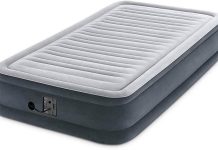Have you ever encountered the frustrating situation of an air mattress that refuses to hold air? We’ve all been there, desperately trying to salvage a good night’s sleep while feeling deflated by the mattress itself. In this article, we’ll explore some tried and tested methods to help you reinflate that troublesome air mattress, allowing you to rest easy once again. So, let’s dive into the world of mattress maintenance and discover the secrets to revitalizing your deflated bed.
Review contents
Identify the Cause of the Leak
Check for visible tears or holes
The first step in repairing an air mattress that won’t hold air is to identify the cause of the leak. One way to do this is by carefully inspecting the mattress for any visible tears or holes. This can be done by visually examining the surface of the mattress and feeling for any irregularities or areas of weakness. Look for any signs of wear and tear, such as worn-out patches or areas where the material is thinning. Identifying any visible tears or holes will help you determine the best approach to fixing the leak and reinflating the mattress.
Listen for the sound of air escaping
Another method to identify the cause of the leak is by listening for the sound of air escaping from the mattress. Inflate the mattress to its maximum capacity and listen for any hissing or whistling sounds. By moving your ear close to the surface of the mattress, you can pinpoint the exact location of the leak. This method is especially useful if the leak is not easily visible or if the mattress has multiple small leaks. Listening for the sound of air escaping will allow you to accurately identify the source of the problem and proceed with the necessary repair.
Use soapy water to detect leaks
If you’re having difficulty locating the leak using the previous methods, using soapy water can be an effective technique. Mix a small amount of dish soap with water and create a soapy solution. Inflate the mattress and apply the soapy solution to the surface of the mattress, focusing on the areas where you suspect the leak might be. Watch closely for any bubbles forming, as this indicates the presence of a leak. The escaping air will create bubbles in the soapy solution, making it easier to spot the exact location of the leak. This method works well for both small and larger leaks, providing a reliable way to detect and identify the cause of the leak.
Repairing Small Leaks
Locate the small hole or puncture
Once you have identified a small leak in your air mattress, the next step is to locate the exact hole or puncture. This can be done by visually inspecting the mattress’s surface or by applying pressure to different areas while feeling for air escaping. Pay close attention to any areas that seem softer or where you can feel a slight rush of air. By locating the small hole or puncture, you will be able to effectively repair it and restore the mattress’s ability to hold air.
Clean and dry the area around the leak
Before repairing a small leak, it’s important to clean and dry the area surrounding the hole or puncture. Use a clean cloth or paper towel to remove any dirt, dust, or moisture from the mattress’s surface. This step ensures that the patch or sealant will adhere properly and create a strong bond. Moisture or debris can interfere with the effectiveness of the repair, so it’s essential to thoroughly clean and dry the area before proceeding.
Apply a patch or sealant
To repair a small leak in an air mattress, you can use a patch or sealant specifically designed for inflatable products. These patches or sealants are often included in air mattress repair kits, which can be purchased online or at camping supply stores. Carefully follow the instructions provided with the patch or sealant to ensure proper application. The patch or sealant should cover the entire hole or puncture, creating an airtight seal. Apply pressure to the patch or sealant to ensure a snug fit and allow it to bond with the mattress’s surface.
Allow the patch or sealant to dry
After applying the patch or sealant, it’s crucial to allow it to dry completely before reinflating the mattress. The drying time can vary depending on the specific product used, so refer to the instructions provided with the patch or sealant. During the drying process, avoid placing any pressure or stress on the repaired area to ensure a strong and durable repair. Once the patch or sealant has dried, you can proceed with reinflating the mattress and enjoy a comfortable night’s sleep.
Repairing Larger Leaks or Tears
Prepare the mattress for repair
Repairing larger leaks or tears in an air mattress requires more extensive preparation. Start by deflating the mattress completely and removing any bedding or covers. This will allow you to have a clear view of the damaged area and ensure a more effective repair. Additionally, wiping down the mattress to remove any dirt or debris will help create a clean and suitable surface for the repair process.
Apply a patch or sealant for larger holes
For larger holes or tears, applying a patch or sealant might not be sufficient. In these cases, it’s recommended to use a repair kit specifically designed for air mattresses. These kits often include heavier-duty patches or adhesive solutions that can effectively seal larger leaks. Carefully follow the instructions provided with the repair kit to ensure a successful repair. Apply the patch or adhesive to the damaged area, making sure to cover the entire hole or tear. Apply pressure to the patch or sealant to ensure proper bonding and allow it to dry thoroughly before reinflating the mattress.
Use a repair kit specifically designed for air mattresses
Repair kits designed specifically for air mattresses are a valuable resource when it comes to fixing larger leaks or tears. These kits typically contain patches, adhesive solutions, and other tools necessary for a successful repair. When purchasing a repair kit, ensure that it is compatible with the type of air mattress you have and that it includes instructions that are easy to follow. Using a repair kit designed for air mattresses will simplify the repair process and increase the chances of a long-lasting and effective solution.
Replacing the Valve
Identify the type of valve
If your air mattress is leaking from the valve itself, it may be necessary to replace the valve altogether. The first step in replacing the valve is to identify the type of valve your mattress has. Common types of valves include twist valves, push-pull valves, and Boston valves. Each valve type requires a specific replacement procedure, so it’s important to accurately identify the valve before proceeding.
Purchase a compatible replacement valve
Once you have identified the type of valve, you can purchase a compatible replacement valve. These replacement valves can typically be found online or at camping supply stores. When purchasing a replacement valve, ensure that it matches the exact specifications of your original valve to guarantee a proper fit. It’s recommended to consult the manufacturer’s instructions or customer service to determine the exact replacement valve needed for your specific air mattress model.
Remove the old valve
To replace the valve, start by deflating the mattress completely and removing any bedding or covers. Locate the existing valve and carefully remove it according to the manufacturer’s instructions. In most cases, the old valve can be unscrewed or pulled out, but the specific removal method may vary depending on the valve type. Take care not to damage the mattress material during the removal process.
Install the new valve
Once the old valve has been removed, it’s time to install the new valve. Follow the manufacturer’s instructions provided with the replacement valve to ensure proper installation. This typically involves inserting the valve into the valve hole and securing it in place using the appropriate method specified. Ensure that the new valve is tightly sealed and securely attached to the mattress. Once installed, test the new valve by inflating the mattress and checking for any air leaks. If the new valve holds air properly, you have successfully replaced the valve and restored the integrity of your air mattress.
Using an Air Mattress Repair Kit
Acquire an air mattress repair kit
If you frequently use an air mattress or anticipate the need for future repairs, it’s beneficial to acquire an air mattress repair kit. These kits are readily available online or at camping supply stores and contain all the necessary tools and materials for repairing air mattresses. Repair kits often include patches, adhesive solutions, valve replacements, and instructions for proper use. Investing in a repair kit can save you time and money in the long run, as you’ll have all the essential items readily available whenever a repair is needed.
Follow the instructions provided in the kit
When using an air mattress repair kit, it’s crucial to carefully follow the instructions provided. Each repair kit may vary in terms of application methods and drying times, so it’s important to adhere to the specific guidelines. Start by identifying the type of repair needed and gather the necessary tools and materials from the kit. Read through the instructions thoroughly and follow the step-by-step process outlined. By following the instructions provided in the kit, you can ensure a successful repair and prolong the lifespan of your air mattress.
Apply the repair solution or adhesive
Depending on the type of repair needed, the repair kit may include a repair solution or adhesive. These solutions are designed to seal leaks, patch holes, or secure damaged areas. Carefully apply the repair solution or adhesive according to the instructions provided. Ensure that the entire affected area is covered and that the solution is evenly distributed. Apply firm pressure to ensure proper adhesion and bonding. This step is crucial in creating a durable and long-lasting repair.
Allow the repair to set and dry
After applying the repair solution or adhesive, it’s important to allow it to set and dry completely. The drying time can vary depending on the specific repair kit and the extent of the repair. Consult the instructions provided with the repair kit for the recommended drying time. During the drying process, avoid placing any pressure or stress on the repaired area to ensure a strong and effective bond. Once the repair has set and dried, you can reinflate the mattress and enjoy its fully restored function.
Preventive Measures
Protect the mattress during use
Preventing air mattress leaks and damages starts with proper protection during use. Place the air mattress on a clean and debris-free surface to minimize the risk of punctures or tears. Avoid placing the mattress on rough or sharp surfaces that can easily damage the material. Additionally, consider using a mattress protector or cover to provide an extra layer of protection and prevent direct contact with potential causes of damage.
Use a mattress protector or cover
Using a mattress protector or cover is an effective way to protect your air mattress from potential damage. These protective layers provide a barrier between the mattress and external elements that could cause leaks or tears. Look for a mattress protector or cover specifically designed for air mattresses, as they are often made of durable materials that can withstand regular use and minimize the risk of punctures or tears. By using a mattress protector or cover, you can extend the lifespan of your air mattress and prevent the need for frequent repairs.
Avoid placing sharp objects near the mattress
To prevent leaks or tears in your air mattress, it’s important to avoid placing sharp objects near it. Keep the mattress away from any sharp edges, tools, or objects that could potentially puncture the material. This includes keeping knives, scissors, or any other sharp items away from the mattress when inflating or deflating it. By maintaining a safe distance from sharp objects, you can reduce the risk of accidental damage and ensure the longevity of your air mattress.
Keep pets away from the mattress
If you have pets at home, it’s essential to keep them away from your air mattress to prevent any accidental damage. Pets’ claws or teeth can easily puncture the material, causing leaks or tears. It’s recommended to keep your air mattress in a separate room or area where pets are not allowed unsupervised. By keeping pets away from the mattress, you can minimize the risk of damage and maintain the mattress’s ability to hold air effectively.
Proper Storage
Deflate the mattress completely
When it’s time to store your air mattress, start by deflating it completely. Ensure that all the air has been released from the mattress before proceeding with the storage process. This will make it easier to fold or roll the mattress and prevent unnecessary strain on the material. Removing all the air from the mattress is an important step in maintaining its quality and longevity.
Clean and dry the mattress before storage
Before storing your air mattress, it’s essential to clean and dry it thoroughly. Wipe down the mattress with a clean cloth or sponge to remove any dirt or moisture that may be present. Pay close attention to the seams and edges of the mattress, as these areas are more prone to accumulating debris. Allow the mattress to air dry completely before proceeding with the storage process. Moisture can cause mold or mildew to develop, leading to potential damage or unpleasant odors. By cleaning and drying the mattress before storage, you can ensure its cleanliness and readiness for future use.
Roll or fold the mattress carefully
Once the mattress has been deflated and cleaned, it’s time to roll or fold it carefully for storage. Start by aligning the edges of the mattress to create a smooth, straight surface. Depending on the size and shape of the mattress, you can either roll it tightly or fold it into a compact shape. If rolling the mattress, begin from one end and gradually roll it towards the other end, applying gentle pressure to compress the mattress as you go. If folding the mattress, fold it in half or thirds, being careful not to crease the material excessively. By rolling or folding the mattress carefully, you can minimize the risk of unnecessary strain or damage to the material.
Store the mattress in a dry and cool place
To maintain the quality and integrity of your air mattress, it’s important to store it in a dry and cool place. Moisture or excessive heat can cause the material to deteriorate or develop mold and mildew. Find a storage area that is clean, dry, and well-ventilated. Avoid storing the mattress in areas prone to temperature fluctuations, direct sunlight, or high humidity. Ideally, store the mattress in a closet or under a bed where it can be protected from external elements that could potentially damage it. By storing the mattress in a suitable environment, you can extend its lifespan and ensure its readiness for future use.
Using External Air Sources
Utilize an electric air pump
When inflating an air mattress that won’t hold air, utilizing an external air source can be helpful. An electric air pump is an efficient and convenient option for inflating the mattress. Connect the air pump to the mattress’s valve and activate it to begin the inflation process. Ensure that the valve is tightly sealed to prevent any air from escaping. Electric air pumps provide a quick and effortless way to inflate the mattress to its desired firmness without straining your lungs or relying on manual inflation methods.
Use a hand pump or foot pump
If an electric air pump is not available, a hand pump or foot pump can be used as an alternative external air source. Hand pumps or foot pumps are manually operated and require physical effort to inflate the mattress. Connect the pump to the mattress’s valve and pump air into the mattress by pushing or stepping on the pump. This method may require more time and effort compared to an electric pump, but it is a reliable option when other external air sources are not accessible. Ensure that the valve is tightly sealed during the inflation process to maximize the mattress’s air retention.
Inflate the mattress slowly and evenly
Regardless of the external air source used, it’s important to inflate the mattress slowly and evenly. Rapid and uneven inflation can put unnecessary strain on the mattress and potentially lead to leaks or tears. Take your time during the inflation process, allowing the mattress to expand gradually and evenly. Monitor the firmness of the mattress as you inflate it and ensure that it reaches the desired level without overinflating. By inflating the mattress slowly and evenly, you can prevent excessive pressure or stress on the material and promote long-lasting durability.
Seeking Professional Repair
Consider professional repair services
If you are unable to repair the air mattress on your own or if the damage is extensive, it may be necessary to consider professional repair services. Professional repair technicians have the expertise and specialized equipment to fix air mattresses effectively. They can assess the extent of the damage, provide expert advice, and apply professional-grade repair techniques. While professional repair services may come at a cost, they can offer a reliable and long-lasting solution, especially for complex or severe damages.
Contact the manufacturer for repair options
If your air mattress is still under warranty, contacting the manufacturer is a recommended course of action. Inquire about their repair options and whether they provide any repair services or replacement parts. Manufacturers often have specific guidelines and processes for repairing their products, and they may offer warranty coverage or discounted repair services. By contacting the manufacturer, you can explore the available options and ensure that the repair is carried out according to the manufacturer’s specifications.
Evaluate the cost and feasibility of repair
Before proceeding with professional repair services, it’s important to evaluate the cost and feasibility of the repair. Consider the extent of the damage and the potential expenses involved in the repair process. Compare the cost of repair to the cost of purchasing a new air mattress to determine the most cost-effective option. Additionally, assess the feasibility of the repair in terms of time and convenience. If the repair process is lengthy or inconvenient, it may be more practical to invest in a new air mattress instead.
Know When to Replace
Assess the overall condition of the mattress
At some point, it may be necessary to assess the overall condition of your air mattress and determine whether it’s time to replace it. Consider the age of the mattress, the frequency of repairs, and the general wear and tear. If the mattress has undergone extensive repairs or if the material is significantly worn out, it may be more practical to invest in a new mattress. Assess the overall comfort and functionality of the mattress to determine if it still meets your needs. If the mattress no longer provides the necessary support or if it has become uncomfortable, it may be the right time to replace it.
Consider the frequency of repairs
Another factor to consider when deciding whether to replace your air mattress is the frequency of repairs. If you find yourself constantly repairing leaks or patches, it may be a sign that the mattress is no longer durable or reliable. Frequent repairs can become time-consuming, expensive, and inconvenient. Evaluate the pattern of repairs and assess whether the cost and effort of repairing the mattress outweigh the benefits. If the frequency of repairs becomes excessive, it’s likely a better investment to purchase a new air mattress.
Evaluate the expense of frequent repairs
While repairing an air mattress can be a more cost-effective solution in some cases, it’s important to evaluate the expense of frequent repairs. Consider the total cost of all the repairs made to the mattress and compare it to the cost of purchasing a new one. If the expense of repairs is approaching or exceeding the cost of a new air mattress, it may be more practical to invest in a replacement. Additionally, factor in the time and effort spent on repairing the mattress and assess whether it’s worth the ongoing maintenance. By evaluating the expense of frequent repairs, you can make an informed decision about when to replace your air mattress.
Decide on purchasing a new air mattress
Ultimately, the decision to replace your air mattress should be based on a combination of factors, including the overall condition, the frequency of repairs, and the expense involved. If the mattress is beyond repair, consistently requires repairs, or no longer meets your needs, it’s likely time to purchase a new one. Investing in a new air mattress ensures that you have a durable, comfortable, and reliable sleeping surface for a long time to come. Consider the features, size, and quality of the new mattress to ensure a suitable replacement that meets your requirements.






























